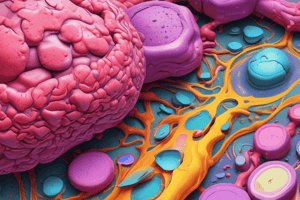Podcast
Questions and Answers
What is the primary aim of disease classification?
What is the primary aim of disease classification?
- Identify the best treatment
- Estimate the prognosis
- Ascertain the cause for prevention
- All of the above (correct)
How are genetic diseases primarily caused?
How are genetic diseases primarily caused?
- Congenital anomalies
- New mutations in affected individuals (correct)
- Pathogenic mechanisms
- Environmental factors
What is the most widely used basis for disease classification?
What is the most widely used basis for disease classification?
- Aetiology and pathogenesis (correct)
- Name of the discovering doctor
- Reversibility of the disease
- Onset of the disease
Which type of disease may not cause clinical manifestation until adult life?
Which type of disease may not cause clinical manifestation until adult life?
Based on pathogenesis, how can most diseases be classified?
Based on pathogenesis, how can most diseases be classified?
What causes acquired diseases?
What causes acquired diseases?
Which term best describes a disease with a rapid onset and often a rapid resolution?
Which term best describes a disease with a rapid onset and often a rapid resolution?
What term is used to classify tumors that remain localized to the tissue of origin and are very rarely fatal?
What term is used to classify tumors that remain localized to the tissue of origin and are very rarely fatal?
Which prefix means 'deficiency below normal'?
Which prefix means 'deficiency below normal'?
Which suffix refers to an abnormal increase in a particular characteristic?
Which suffix refers to an abnormal increase in a particular characteristic?
What is the primary purpose of uniform nomenclature in pathology and medicine?
What is the primary purpose of uniform nomenclature in pathology and medicine?
How is 'primary' used in the nomenclature of diseases?
How is 'primary' used in the nomenclature of diseases?
What defines a disease according to the text?
What defines a disease according to the text?
What is the purpose of clarifying common terms, prefixes, and suffixes in disease nomenclature?
What is the purpose of clarifying common terms, prefixes, and suffixes in disease nomenclature?
Benign tumors commonly invade and spread from their origin, making them commonly fatal.
Benign tumors commonly invade and spread from their origin, making them commonly fatal.
The prefix 'Hypo-' means excess over normal.
The prefix 'Hypo-' means excess over normal.
Malignant tumors have a prolonged course lasting months or years.
Malignant tumors have a prolonged course lasting months or years.
Dysplasia indicates a disordered inflammatory process.
Dysplasia indicates a disordered inflammatory process.
Uniform nomenclature in pathology and medicine does not aid in accurate epidemiological studies.
Uniform nomenclature in pathology and medicine does not aid in accurate epidemiological studies.
The term 'secondary' in the nomenclature of diseases always refers to a disease without an apparent cause.
The term 'secondary' in the nomenclature of diseases always refers to a disease without an apparent cause.
Clinical manifestations of a disease are always limited to signs and not symptoms.
Clinical manifestations of a disease are always limited to signs and not symptoms.
The inability of an organism to adapt to a challenge always leads to a loss of normal health.
The inability of an organism to adapt to a challenge always leads to a loss of normal health.
Graves' disease is a congenital disease initiated before or during birth.
Graves' disease is a congenital disease initiated before or during birth.
Acquired diseases are caused solely by genetic mutations.
Acquired diseases are caused solely by genetic mutations.
Congenital diseases may not cause clinical manifestation until adult life.
Congenital diseases may not cause clinical manifestation until adult life.
Inflammatory diseases fall under the category of acquired diseases.
Inflammatory diseases fall under the category of acquired diseases.
The most widely used basis for disease classification is the reversibility of a disease.
The most widely used basis for disease classification is the reversibility of a disease.
Classification of diseases is commonly based on the name of the doctor who discovered it.
Classification of diseases is commonly based on the name of the doctor who discovered it.
Study Notes
- Nomenclature of disease refers to the system of names used in pathology and medicine to communicate effectively and enable accurate epidemiological studies.
- Disease is defined as a condition causing a loss of normal health due to the presence of an abnormality, which can be structural or functional, and is due to an organism's inability to adapt to a challenge.
- Nomenclature of disease includes primary and secondary meanings:
- Primary: describing causation (essential, idiopathic, spontaneous, cryptogenic) or initial and subsequent stages (most commonly in cancer).
- Secondary: describing a complication or manifestation of an underlying lesion.
- Nomenclature also differentiates between acute and chronic diseases, and benign and malignant tumours.
- Prefixes and suffixes are used to modify the meaning of disease names:
- Prefixes: ana- absence, dys- disordered, hyper- excess, hypo- deficiency, meta- change, neo- new, and neoplasia- neoplasm.
- Suffixes: -itis, inflammatory process; -oma, tumour; -osis, abnormal increase; -oid, bearing resemblance; -plasia, disorder of growth; and -opathy, abnormal state lacking specific characteristics.
- Eponymous names are given to diseases or lesions after a person or place associated with them, such as Graves' disease or Crohn's disease.
- Disease classification is used to identify a disease in an individual patient, with aims to determine the best treatment, estimate the prognosis, and ascertain the cause for prevention.
- The most widely used disease classifications are based on causes (aetiology) and underlying mechanism (pathogenesis).
- Genetic diseases are caused by abnormalities in the genome, mostly inherited but also due to new mutations.
- Acquired diseases are caused by environmental factors, including genetic and environmental interactions.
- Diseases can be classified into Congenital and Acquired based on pathogenesis:
- Congenital diseases: initiated before or during birth, with ~5% of births in the UK, and some may not cause clinical manifestation until adult life.
- Acquired diseases: caused by external factors and can be classified into Inflammatory, Haemodynamic, Growth disorders, Injury and disordered repair, Disordered immunity, and Metabolic and degenerative disorders.
- In a lecture MCQ test, the correct answer is "e) None of the above" for the question on the basis of classification of diseases.
- In a lecture question and discussion, the topics covered were Congenital, Acquired, Infectious, and Non-infectious diseases.
Studying That Suits You
Use AI to generate personalized quizzes and flashcards to suit your learning preferences.
Related Documents
Description
Learn about the nomenclature and classification of diseases in the fields of pathology and medicine. Understand the concept of diseases, familiarize with standard conventions for naming diseases, and describe how diseases are classified. Explore the significance of uniform nomenclature in communication and accurate epidemiological studies.




